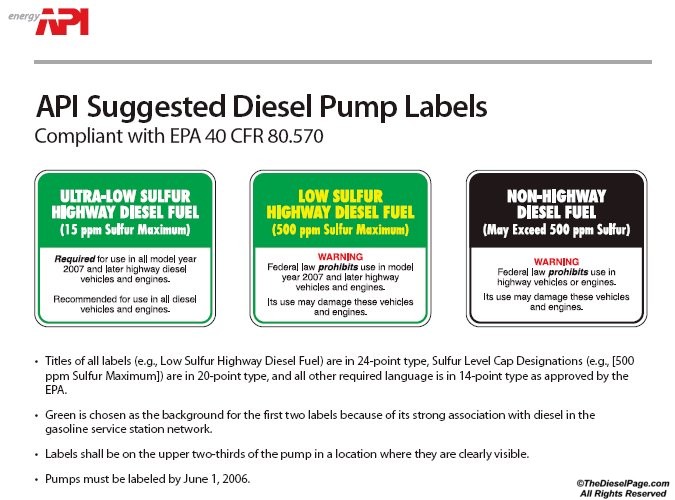There have been many changes in the last few years to the ASTM (American Society for Testing and Materials) D975 standard for diesel fuel. In January 2005 a new fuel lubricity standard ASTM D6079 was established for diesel fuel. This is a test method for evaluating lubricity of diesel fuel as measured by the HFRR (High Frequency Reciprocating Rig) Test with a wear scar not to exceed 520 microns. In all likelihood lubricity will be added at the refinery. Because this test is not precise there is an acceptable variance from 520 to 570 micron. Since it is more expensive to get the fuel down to the 520 micron wear scar most fuels will probably be closer to the 570. Lubricity is also more crucial for the smaller pickups and small cars than the big rigs. According to a study conducted by BOSCH ,which includes the interest of Stanadyne, Siemens, Denso and Delphi, the new standard for light duty fuel injection equipment is not even borderline. They are saying that the fuel needs to be at least 460 micron and they really want, but will not get, a HFRR 380 micron. In their study they say that for DFIE (diesel fuel injection equipment) fuel lubricity is the most valuable and crucial property and that Common-rail and Rotary pumps require the same level of lubricity. It should also be pointed out that injectors also benefit from better fuel lubricity. DFS, Diesel Kleen and Diesel 911 will get the lubricity of the fuel below the HFRR 520 and provide excellent fuel pump protection.
For the fuel pumps in diesel vehicles the fuel is the lubricating agent. If the fuel does not have adequate lubricity the fuel pumps will wear faster and can end in damage and pump failure. Power Service has several products that provide excellent lubricity protection and are labeled with the SlickDiesel logo. Diesel Fuel Supplement (DFS), Diesel Kleen and Diesel 911 all contain this excellent lubricity package. Diesel Fuel Supplement is the Number 1 selling diesel fuel additive in the USA. It is the best product to use for winter and it contains detergents to keep injectors from getting dirty, Cetane Boost to help with faster and easier engine starts, reduced emissions and white smoke, lessens engine noise and aids in faster engine warm-up. DFS contains SlickDiesel for excellent lubricity protection. When using the quart and 96-ounce containers a single treat is 1-ounce to each 3-gallons of fuel. If you add 25 gallons to your fuel tank then you would add 9-ounces of DFS (25 divided by 3 equals 8.3 [round fractions up to the next whole number] or 9-ounces of DFS). To add a double treat then just double this number or add 18-ounces. Diesel Kleen is the best non-winter product that you can use and is the Number 2 selling diesel fuel additive in the USA. Diesel Kleen does not have an antigel so it contains more detergents and more Cetane Boost than DFS. The detergents are strong enough to clean up dirty injectors within the spray pattern range of a new injector. Diesel Kleen will give even better fuel economy and will pay for itself when used with every fillup. Diesel Kleen has a better stability package, will increase the Cetane Boost of the fuel even better than DFS and also contains SlickDiesel. Both products will also help control condensation. The treat rate for Diesel Kleen in the quart and 96-ounce containers are the same as for DFS. Diesel 911 is the third best selling diesel fuel additive in the USA and it also contains SlickDiesel. Diesel 911 is intended to be used to get people out of trouble especially during the winter. Free water causes about one-third of all fuel flow problems in the winter. Diesel 911 does not contain an antigel but it will disperse water and help prevent water related problems in both summer and winter. Use Diesel 911 just before winter to disperse water caused by condensation and to prevent fuel filter icing when the first cold spell hits. Use 1 gallon to each 200 gallons of fuel or 1-ounce to each 1.5 gallons of fuel to pre-treat fuel tanks. Diesel 911 can also be used to de-ice frozen fuel filters and help to reliquefy gelled diesel fuel in big rigs. Diesel 911 also contains SlickDiesel.
DFS and Diesel Kleen are made to be used with every fillup and will solve most of the problems associated with diesel fuel. When you use these with every fillup your equipment will work better, last longer and have fewer repairs. The increase in fuel economy alone will pay for the additive and the other benefits are the icing on the cake.
I hope this answers some of your questions about our products and lubricity issues with the new Ultra Low Diesel Fuels coming on the market. Let me know if you have any other questions or concerns.
Best regards,
Power Service Products, Inc.







 Reply With Quote
Reply With Quote







 So with that and the Bio I'm not gonna sweat it. Again thanks for the info, good reading.
So with that and the Bio I'm not gonna sweat it. Again thanks for the info, good reading.

